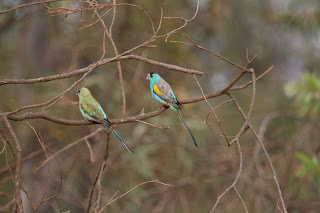Artemis Station
John Griffiths had suggested we stay at Artemis Station,
just south of Musgrave Roadhouse to see the endangered Golden Shouldered Parrot
so we pulled in at 6pm and met Trevor who apologised that his mother wasn’t
here but he would do his best to show us the rare bird. The other campers here
are 4 archeologists from several universities here to excavate the native
mounted police camp just up the road. Their project involves over 50 similar
camps over QLD and northern NSW to find out how they operated. Apparently there
is no written information about these services although they were vital in
enabling white settlement in pastoral and gold mining areas. Local aboriginal people
understandably objected to white settlement and undermined the settlement
activity. Aboriginal men were bought in from distance places, drawn from
dysfunctional communities, presumably because young men in functional
communities wouldn’t agree to such an offer. Their work included protecting the
white settlements against local aboriginal guerrilla warfare, often including
extensive violence. The archeologists are interested in many aspects,
particularly what motivated these young men to agree to these roles. They
offered us the opportunity to watch them work as we waited for Sue the owner to
return to Artemis and show us the golden shouldered parrot, but they said that
as this was their first day, they would probably only be identifying the
squares where they would subsequently start digging.
Next morning we set off with Trevor at day break and
searched for about 1.5 hours for the elusive parrot without any luck. We did
see the white fronted cuckoo shrike, white throated honeyeaters, bee eaters,
bowerbirds, rainbow lorikeets and quite excitingly the pacific Baza which we’ve
never before photographed. Russ got some magnificent shots. We let Trevor know
that we’d love to help him out on the station while we waited for Sue to
return. He invited us up for smoko which was one big laugh as we heard about
many aspects of station life and they took the mickey out of bird watching and
wildlife caring in the nicest way. They are all very dry and funny. We repeated
our offer but nothing has eventuated yet, although they said to come to the
cattle yards after lunch. So we busied ourselves with various overdue jobs
around our camp. It’s a lovely sunny day and very peaceful as we look out on
scrubby country with termite mounds everywhere.
We cooked our fish for everyone for dinner and had a really fun evening with them. Their parents came home later and a friend of theirs called Darren came over too. He'd got up at 2am that morning to drive to Aurukun to do some plumbing work that he employees hadn't finished and had arrived back at Artemis at 8pm. A very long drive.
We met Sue at 7am next morning and she found the parrots near a tiny water hole after a few minutes. She could hear their call and knew the sort of places they would be. She took us to 2 other spots and we found the parrots there too. We were thrilled. We then had morning tea with everyone and thanked them all. We popped down to the cattle yards and watched them drafting weaners that would be taken to distant feed lots to put on weight before being sold. There were 5 people working the cattle and it was all fairly calm. We left feeling amazed by these very generous spirited people who live quite a challenging life in an apparently unstressed way.
Sue told us a lot about the survey work she does for NP using maps of the 4 or so local stations, divided in 5km squares. She goes up one side of the creek and down the other side. She goes out for days at a time on the bike with just a blow up mattress and presumably some food. She trains a lot of local people through national parks, to do the survey work but worries that they're not committed. She told us about the Japanese, German and British film crews that have come and stayed months at a time, to film the parrots. Her name is on tens of academic papers but this is of no interest what so ever to her.
She said that because of the feral cats and goannas predating the nests, because of goats, wallabies and cattle eating the cockatoo grass that they love and various other factors, these parrots will be extinct in the near future. There are only 150 breeding pairs left.
Tom trains station staff to manage cattle and horses in NT
Trevor works at home
Full moon
Pacific Baza
Masked Finches
Flycatcher
Rainbow Bee Eater
Banded Honeyeater
Rainbow Lorikeet
Beautiful Brahmin Cattle
Juvenile Comb Crested Jacana
The Golden Shouldered Parrots - males have the gold on their shoulder and the females are mainly green
I couldn't resist including these Rainbow Bee Eaters with the great light on them



























0 Comments:
Post a Comment
Subscribe to Post Comments [Atom]
<< Home